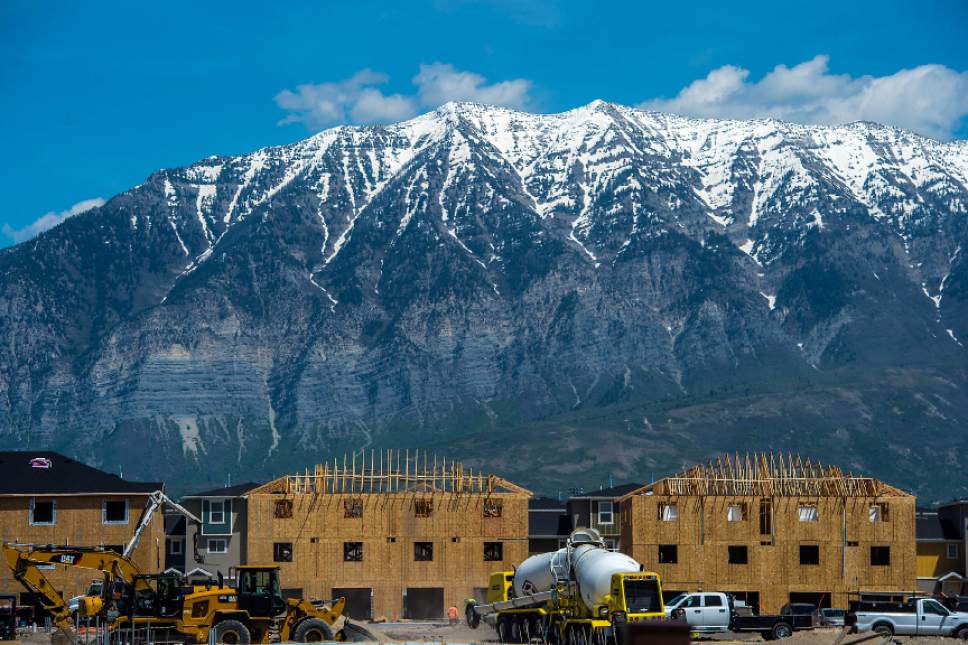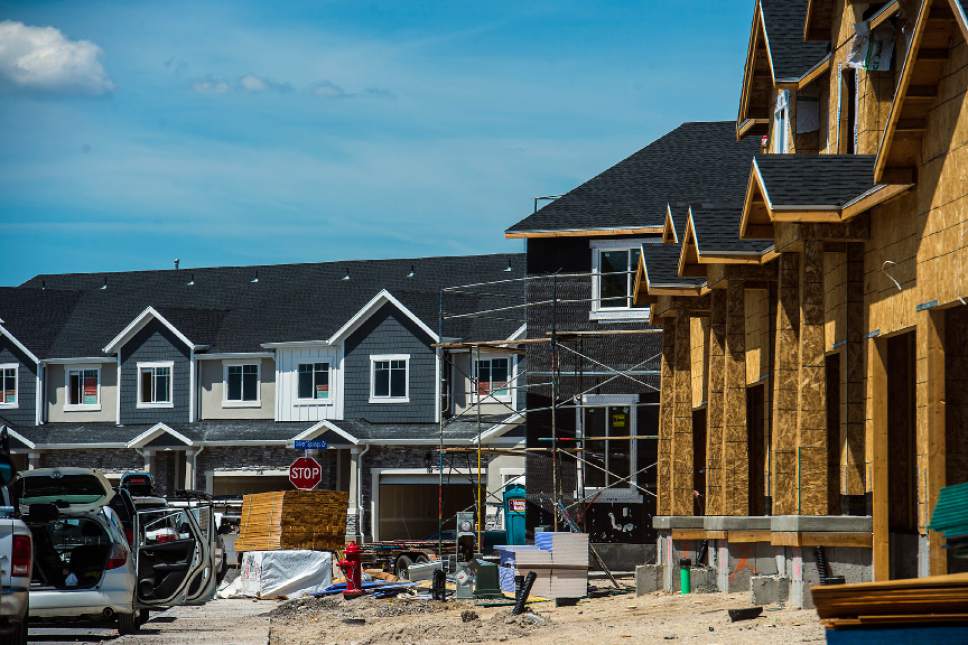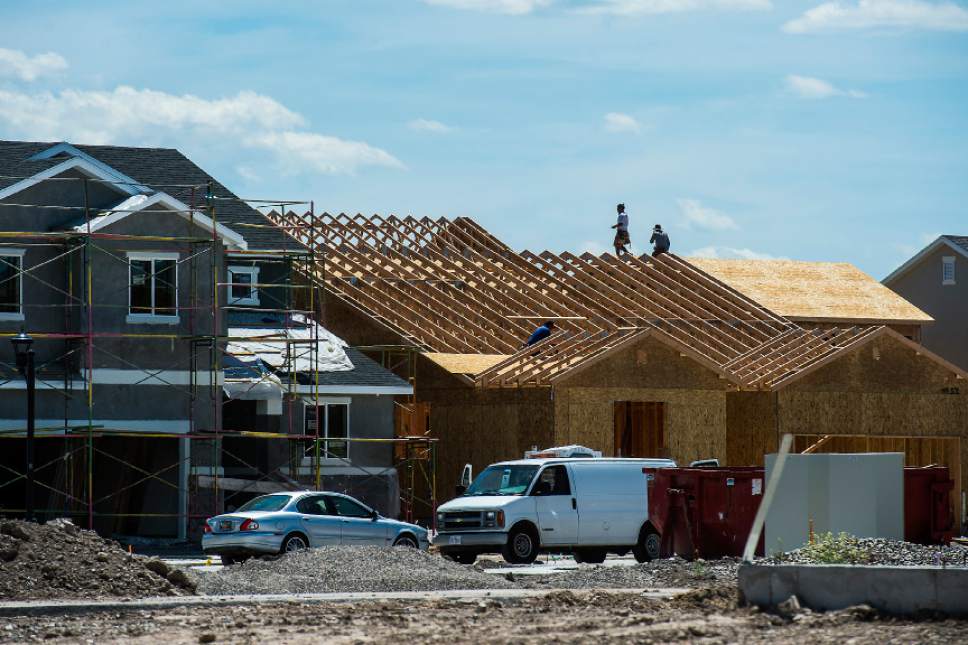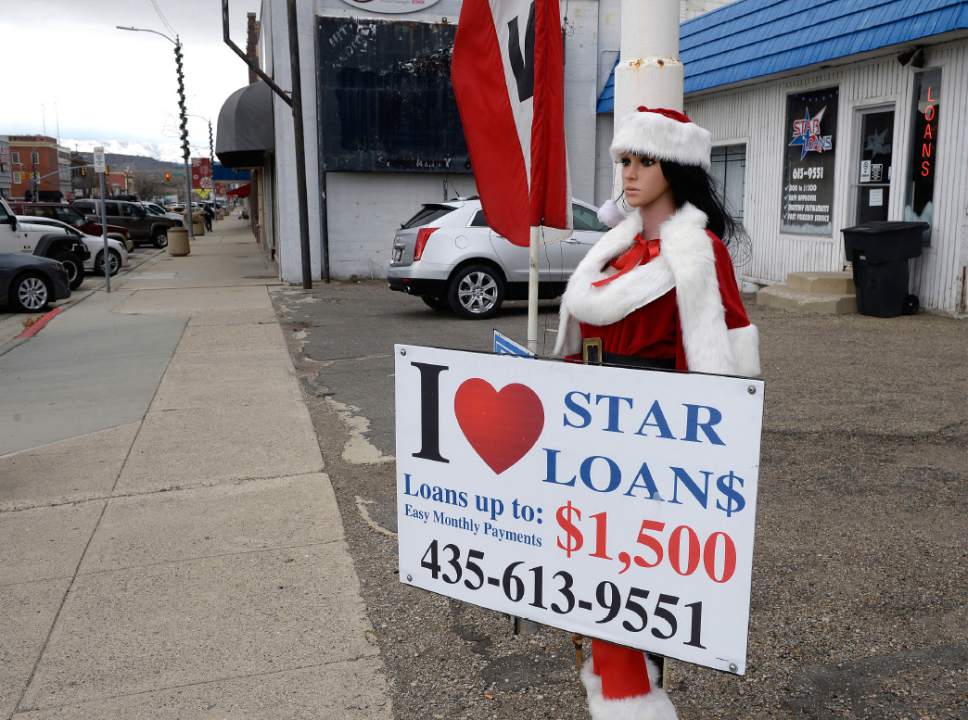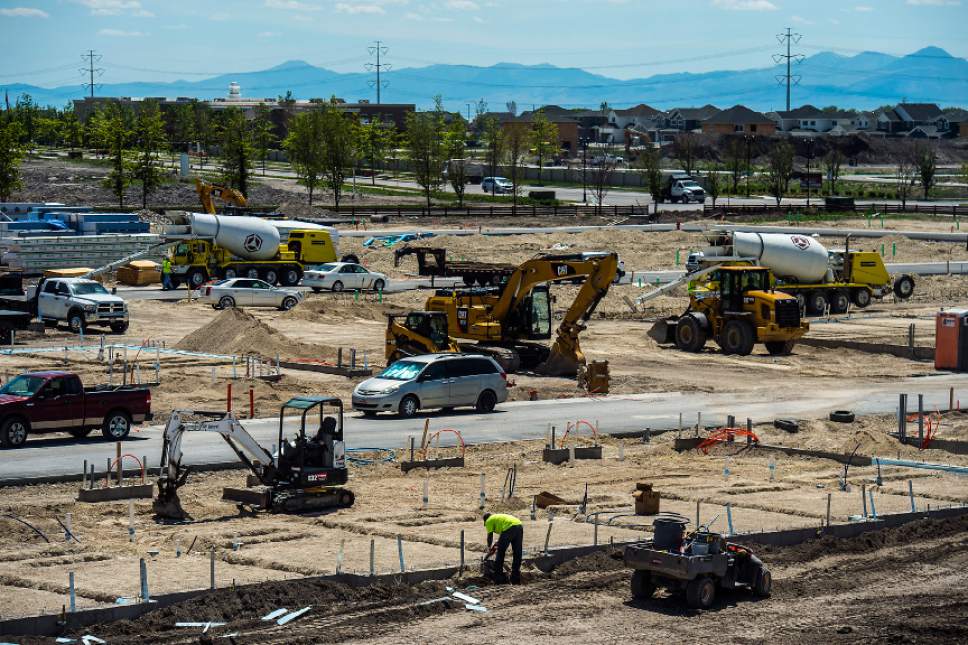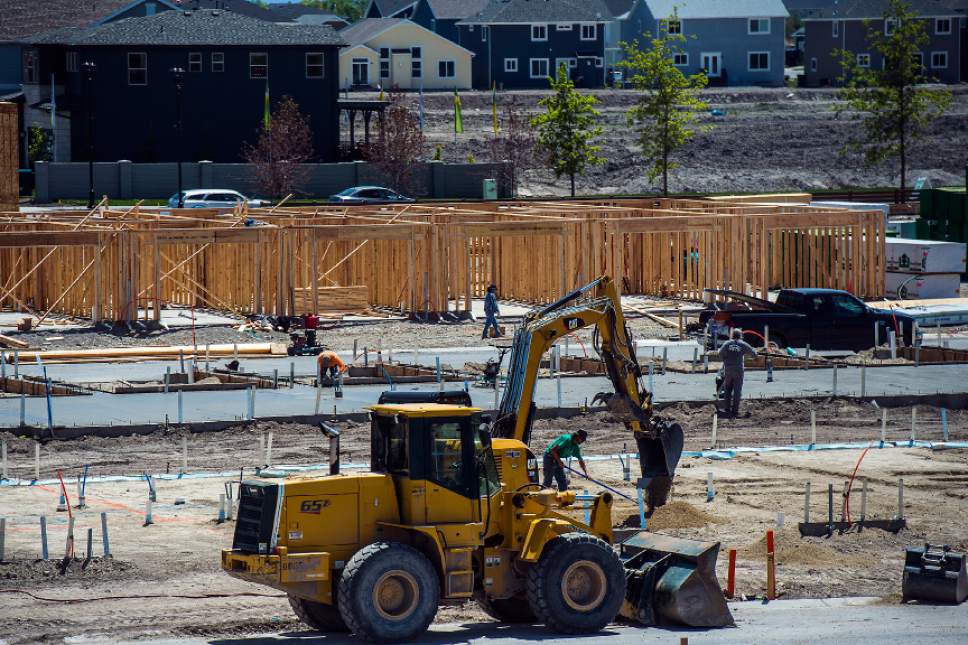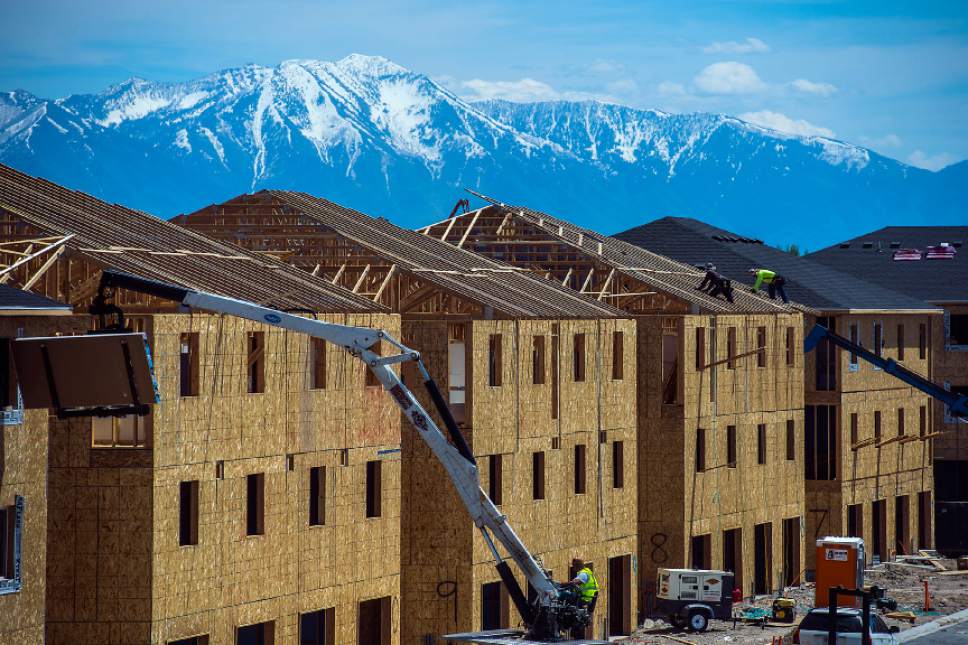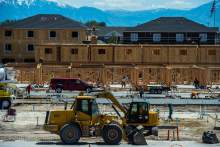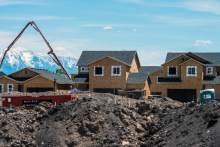This is an archived article that was published on sltrib.com in 2017, and information in the article may be outdated. It is provided only for personal research purposes and may not be reprinted.
The Utah County town of Vineyard grew sixfold in the past two years — from 611 residents to 3,953 — as new homes mushroomed on and around the old Geneva Steel plant site.
But City Manager Jacob McHargue says those newly released U.S. Census Bureau estimates are for 2016, and he figures the town's population has already expanded to 8,000 residents by now, based on the number of recently completed and occupied homes.
Vineyard was the fastest-growing city or town of any size in the state last year. And Utah, as previously reported, leads the nation in population growth.
New 2016 population estimates for cities nationwide, released Thursday, also show that Lehi was the 11th fastest-growing city in the nation by percentage among those with populations greater than 50,000. And Logan topped 50,000 residents.
The data show that 202 of Utah's 246 cities and towns gained residents, 37 lost population and seven remained unchanged. "We're fortunate we are talking about growth instead of decline, because a lot of cities in the nation are still experiencing economic and population decline," said Pam Perlich, demographics director at the University of Utah's Kem C. Gardner Policy Institute.
—
Vineyard • The highlight of the new data may be the continuing transformation around the old steel plant site on the east side of Utah Lake.
McHargue said people are flocking to Vineyard because available land is hard to find elsewhere in the middle of Utah County. "Vineyard's in a unique situation because none of this land was available 10 years ago. Some of it was in the Geneva Steel site, and a lot of it was farmland."
So, he said, "We're really building a city from the ground up. I think people are really excited about being part of a community that is brand new across the board."
McHargue argues this start-from-scratch development has big advantages.
"We are able to cater to the needs of the current residents, rather than trying to retrofit those," he said. One example: "All of our major roads have trails associated with them."
A town center under development "is going to be extremely walkable," McHargue said. "That will be where the [planned] FrontRunner station is. There are going to be residential and commercial areas. There's a boardwalk that will go from the station to the lake, so you can live, work and play all in that same area."
Vineyard's official growth rate in 2016 was 24 percent, the highest by far in the state. (Herriman was a distant second at 15 percent).
McHargue said that growth is aided by easy accessibility, including three exits off of Interstate 15, with a fourth planned.
"We did over 1,000 building permits last year, and we're on track to do that again this year," he said. In a town that is just 5 square miles in size, that means "you can see growth in every direction." The Geneva development there is expected to add as many as 27,000 people in a decade.
McHargue said housing is available in all price ranges "from town homes to some homes that cost $1 million." The most expensive are along the shore of Utah Lake.
—
Growth central • Southwestern Salt Lake County and adjacent northern Utah County continue to be the growth center of the state, fueled in part by the "Silicon Slopes" development of high-tech companies in Lehi and the jobs that creates.
"That is definitely the hot spot," Perlich said, adding that is in part because it has plenty of available land for growth.
Lehi saw 4.6 percent growth last year, up from 58,428 residents to 61,130.
Lehi also passed Taylorsville to become the state's 11th largest city.
"Lehi is as close to heaven as most people will get in this lifetime," said Mayor Bert Wilson. "It's a great place to live, a great place to work, and a great place to recreate with some great family values."
Wilson pointed to Silicon Slopes as the big driver for Lehi's growth.
"We have room for business development. We have room for residential development, with plenty of dirt to build on. We have a great lifestyle."
Homebuilders simply can't construct homes fast enough to keep up with demand.
The three fastest-growing cities by percentage in Utah are in the same general area: Vineyard (24.2 percent); Herriman (14.7 percent) and Bluffdale (8.3 percent). Some others with fast growth there include Eagle Mountain (7 percent), Saratoga Springs (6 percent), South Jordan (3.8 percent) and Riverton (2.4 percent).
Herriman added more residents last year than any other Utah city, 4,548. Orem was No. 2, adding 3,166; Lehi was No. 3 with 2,702; and South Jordan was No. 4 with 2,521. Salt Lake City trailed those new-growth areas at No. 5, adding 2,306 residents.
Perlich says one reason that southern Salt Lake and northern Utah counties see accelerated growing is improvement in transportation between them, including the addition of FrontRunner rail service and widening and improvement to I-15. "The connectivity between the two counties improved over the last few years."
Herriman City Manager Brett Wood said people are also attracted to his city "because it's one of the last chances" to find plenty of available land "to have a good quality of life and still be close to jobs."
Prices in Herriman range from about $250,000 for town homes to $2 million for some large new houses. One new subdivision has only $1 million-plus homes.
Wood said his city has worked hard to provide amenities people want, including plenty of open space, parks, trails and even a reservoir where swimming is allowed. "We try to find something for everyone."
It is building a new City Hall, having outgrown its old one with several officials now with desks in the halls.
—
Urban sprawl • Perlich notes that data also show quick growth in counties that ring the urban area.
"The metropolitan area continues to expand," she said. "A lot of it is what we call urban sprawl."
Some growing cities just outside of current urban areas include: Heber City, up 4.8 percent; Midway, up 4.9 percent; Santaquin, up 4.7 percent; Grantsville, up 4.5 percent; and North Logan, up 4.1 percent.
Perlich said such numbers indicate growth is swallowing open farmland.
Cities in southern Utah's Washington County also are booming and expanding, in part by attracting people who want to retire or vacation there, Perlich said.
St. George grew by 2.7 percent; Washington City by 4.4 percent; and Santa Clara by 3.3 percent.
—
Declines • While most Utah areas are growing and enjoy strong economies, others are in decline.
"Vernal lost 433 people last year," 3.9 percent of its 11,000 residents, Perlich noted. That came after the Uinta Basin oil and gas boom went bust because of low prices internationally.
Other Uinta Basin cities and towns that lost population include: Naples, down 3.5 percent; Altamont, down 3 percent; Tabiona, 2.9 percent; Duchesne, 2.8 percent; Myton, 2.4 percent; and Roosevelt, 1 percent.
Utah's coal country is also losing population as most mines have shut down. For example, Huntington, Cleveland and Castle Dale all had populations decline by 1.3 percent.
"Some other rural areas are struggling, too," Perlich said.
In fact, almost all of the Utah cities losing population are in rural areas. Some examples are Junction in Piute County, down 3.9 percent; Kingston, Piute County, down 3.7 percent; Circleville, Piute County, 3.3 percent; and Manila, Daggett County, 2.1 percent.
Twitter: @LeeHDavidson —
Utah's largest cities, 2016
1. Salt Lake City, 193,744
2. West Valley City, 136,574
3. Provo, 116,868
4. West Jordan, 113,699
5. Orem, 97,499
6. Sandy, 95,836
7. Ogden, 86,701
8. St. George, 82,318
9. Layton, 75,655
10. South Jordan, 69,034
11. Lehi, 61,130
12. Taylorsville, 60,436
13. Logan, 50,676
Source: U.S. Census Bureau estimates. —
Top percentage-growth cities, 2016
1. Vineyard, 24.2%
2. Herriman, 14.8%
3. Bluffdale, 8.3%
4. Elk Ridge, 7.9%
5. (tie) Mantua, 7.5%
Monticello, 7.5%
7. Eagle Mountain, 7.0%
8. Blanding, 6.9%
9. Saratoga Springs, 6.0%
10. (tie) Pleasant View, 5.0%
Vernon, 5.0%




